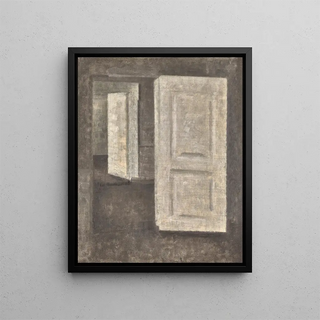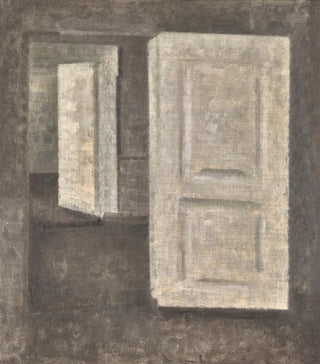Art print | White doors: Strandgade 25 - Vilhelm Hammershøi


View from behind

Frame (optional)
Portes blanches : Strandgade 25 - Vilhelm Hammershøi – Captivating Introduction
In the fascinating world of art, some works stand out for their ability to capture the essence of a moment, a place, or even an emotion. "Portes blanches : Strandgade 25" by Vilhelm Hammershøi is a perfect example. This painting, which evokes the serenity of a Danish interior, transports the viewer to a space where light and shadow dance in harmony. Contemplating this piece, one is immediately struck by the silence that seems to reign, as if time has frozen in a moment of reflection. The art print of this work is an invitation to explore not only the artist's technique but also the unique atmosphere he manages to create.
Style and uniqueness of the work
Hammershøi is recognized for his distinctive style, which blends realism and impressionism. In "Portes blanches : Strandgade 25," he uses soft colors and clean lines to depict a light-filled interior. The white walls, open doors, and play of shadows reveal an atmosphere of calm and intimacy. The artist skillfully plays with light, which appears to filter through the windows, creating subtle reflections on surfaces. This treatment of light is emblematic of his work, where every detail is carefully considered to evoke a sense of peace. The composition is both simple and complex, inviting the viewer to immerse themselves in the nuances of this domestic scene. Hammershøi manages to transform an ordinary moment into an unforgettable visual experience, making this piece a masterpiece of Danish art.
The artist and his influence
Vilhelm Hammershøi, born in 1864 in Copenhagen, is often regarded as one of the greatest Danish painters of his time. His work is deeply influenced by the artistic movements of the late 19th century, notably symbolism and impressionism. Hammershøi developed a unique approach that combines modern sensitivity with a more classical artistic tradition. His works, often centered on interiors, reflect introspection and a quest for beauty in the banal

Matte finish

View from behind

Frame (optional)
Portes blanches : Strandgade 25 - Vilhelm Hammershøi – Captivating Introduction
In the fascinating world of art, some works stand out for their ability to capture the essence of a moment, a place, or even an emotion. "Portes blanches : Strandgade 25" by Vilhelm Hammershøi is a perfect example. This painting, which evokes the serenity of a Danish interior, transports the viewer to a space where light and shadow dance in harmony. Contemplating this piece, one is immediately struck by the silence that seems to reign, as if time has frozen in a moment of reflection. The art print of this work is an invitation to explore not only the artist's technique but also the unique atmosphere he manages to create.
Style and uniqueness of the work
Hammershøi is recognized for his distinctive style, which blends realism and impressionism. In "Portes blanches : Strandgade 25," he uses soft colors and clean lines to depict a light-filled interior. The white walls, open doors, and play of shadows reveal an atmosphere of calm and intimacy. The artist skillfully plays with light, which appears to filter through the windows, creating subtle reflections on surfaces. This treatment of light is emblematic of his work, where every detail is carefully considered to evoke a sense of peace. The composition is both simple and complex, inviting the viewer to immerse themselves in the nuances of this domestic scene. Hammershøi manages to transform an ordinary moment into an unforgettable visual experience, making this piece a masterpiece of Danish art.
The artist and his influence
Vilhelm Hammershøi, born in 1864 in Copenhagen, is often regarded as one of the greatest Danish painters of his time. His work is deeply influenced by the artistic movements of the late 19th century, notably symbolism and impressionism. Hammershøi developed a unique approach that combines modern sensitivity with a more classical artistic tradition. His works, often centered on interiors, reflect introspection and a quest for beauty in the banal






